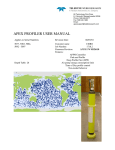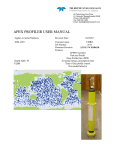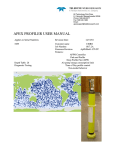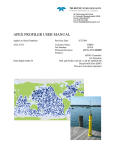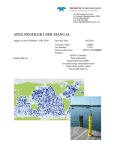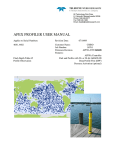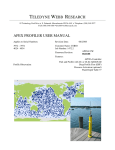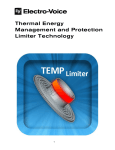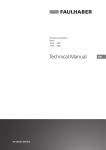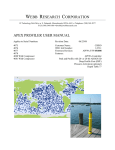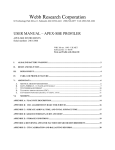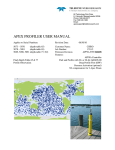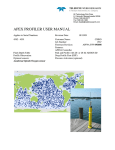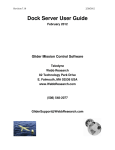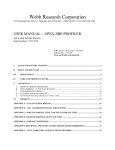Download APEX PROFILER USER MANUAL - CSIRO Marine and Atmospheric
Transcript
TELEDYNE WEBB RESEARCH A Teledyne Instruments, Inc. Company 82 Technology Park Drive E. Falmouth, Massachusetts 02536 Phone: 508.548.2077 Fax: 508.540.1686 Email: [email protected] APEX PROFILER USER MANUAL Applies to Serial Numbers: Revision Date: 4577 - 4581 Customer name CSIRO Job Number: 1617 Firmware Revision APF9I F/W 07/02/07 Features: APF9I Controller Park and Profile Deep Profile First (DPF) Pressure Activation (optional) Air pump energy consumption limit Time of Day profile control Depth Table 26 Ice Detection and Evasion 07/22/09 I. Alkaline Battery Warning.....................................................................................................4 II. APF9 Operations Warning for APF8 Operators.............................................................5 III. APF9I Operations Warning for APF9A Operators ........................................................6 IV. Maximum Operating Pressure .........................................................................................6 V. Evaluating the Float and Starting the Mission ...................................................................7 A. Manual Deployment with the Reset Tool .................................................................................. 8 B. Pressure Activation Deployment ................................................................................................ 9 C. Mission Activation and Operator Float Function Check ...................................................... 12 D. Notes and Caveats...................................................................................................................... 15 VI. Deploying the Float.........................................................................................................16 VII. Park and Profile ..............................................................................................................17 A. Profile Ascent Timing................................................................................................................ 17 B. Profile and Profile Cycle Schematics....................................................................................... 18 VIII. Deep Profile First (DPF) ............................................................................................19 IX. X. Air Pump Limits..............................................................................................................19 Setting the Real-Time Clock...............................................................................................20 XI. Time of Day (TOD) .........................................................................................................21 XII. Ice Detection and Evasion ..............................................................................................23 A. Ice Cover Detection.................................................................................................................... 23 B. Ice Cap Detection....................................................................................................................... 23 C. Ice Break Up Detection ............................................................................................................. 23 D. Ice Detection Mission Parameters............................................................................................ 24 E. Ice Evasion Telemetry ............................................................................................................... 24 F. Special Mission Prelude Note for under-ice operation .......................................................... 24 XIII. Iridium Data................................................................................................................25 A. Iridium Service and Costs......................................................................................................... 25 B. The Float's Iridium Modem and Two-Way Communications .............................................. 27 C. Modem-to-Modem vs. RUDICS ............................................................................................... 29 D. Bearer Service Type .................................................................................................................. 30 E. Iridium Data............................................................................................................................... 31 F. Pressure Table for PTS Samples.............................................................................................. 36 G. The Remote UNIX Host ............................................................................................................ 37 2 of 54 Appendix A: Storage conditions................................................................................................42 Appendix B: Connecting a Terminal ........................................................................................43 Appendix C: APF9I Command Summary ................................................................................44 Appendix D: Returning APEX floats for factory repair or refurbishment ..............................49 Appendix E: Missions .................................................................................................................50 3 of 54 I. Alkaline Battery Warning The profiler contains batteries comprised of alkaline manganese dioxide "D" cells. There is a small but finite possibility that batteries of alkaline cells will release a combustible gas mixture. This gas release generally is not evident when batteries are exposed to the atmosphere, as the gases are dispersed and diluted to a safe level. When the batteries are confined in a sealed instrument mechanism, the gases can accumulate and an explosion is possible. Teledyne Webb Research has added a catalyst inside of these instruments to recombine hydrogen and oxygen into H2O, and the instrument has been designed to relieve excessive internal pressure buildup by having the upper end cap release. Teledyne Webb Research knows of no way to completely eliminate this hazard. The user is warned, and must accept and deal with this risk in order to use this instrument safely as so provided. Personnel with knowledge and training to deal with this risk should seal or operate the instrument. Teledyne Webb Research disclaims liability for any consequences of combustion or explosion. Acknowledgements Teledyne Webb Research would like to acknowledge the contribution made by the University of Washington, School of Oceanography, towards the technical content of this User Manual. 4 of 54 II. APF9 Operations Warning for APF8 Operators This APEX manual describes floats using a new controller design. The new design is designated APF9. The prior design, which is still in production and widely used, is designated APF8. The operator interface and behavior of the APF9 are similar to, but not identical to, the operator interface and behavior of the APF8. If you are an experienced APF8 user, please observe appropriate cautions and do not assume an expected behavior. Several important differences are listed below. These points should also be helpful to those without an APF8 background. • To reset an APF9 for a deployment you should hold the Reset Tool stationary against the RESET label until you hear the air pump run. Typically, the air pump will run 2 to 3 seconds after you position the Reset Tool over the RESET label. (For the APF8 it was necessary to hold the Reset Tool in place and then remove it to trigger the float.) • The serial baud rate for communications is 9600, with 8 data bits, no parity, and 1 stop bit. (The APF8 baud rate is 1200.) • If not already in Command Mode, an APF9 can only enter Command Mode from Sleep. Either the Reset Tool or a keystroke at the terminal will trigger the transition from Sleep to Command Mode. • If the APF9 is performing some task (e.g., self tests), it is not listening and cannot be placed in Command Mode with either the Reset Tool or a keystroke at the terminal. o There is one exception. If the piston is moving, the Reset Tool (but not a keystroke) can be used to terminate the move. The APF9 will transition to its next state or task. Typically this will be either Command Mode or Sleep, so try a keystroke or a second application of the Reset Tool after the piston stops to confirm or trigger the transition to Command Mode. • If the APF9 is not responding, it is probably busy with some task. Be patient and occasionally try to get the attention of the float with either the Reset Tool or a keystroke. • The logging verbosity of the APF9 can be adjusted by the operator. The level, Parameter D, Logging verbosity [0-5], adjusts the amount of information provided in diagnostic messages from the float, with 5 being the highest level. A logging verbosity of 2 is the default. Only level 2 has been thoroughly tested in simulation, so this parameter should be set to 2 for all deployments. Higher levels are suitable during testing as an aid to float assessment. 5 of 54 III. APF9I Operations Warning for APF9A Operators The "look and feel" of the APF9I operator interface is quite similar to the APF9A operator interface. However, there are some differences of which you should be aware: • The APF9I uses minutes, not hours, for mission parameter timing intervals • Air bladder inflation is the only visible evidence that the float passed the self-test and is ready for deployment. The APF9I does not make six test transmissions that can be detected with an external RF receiver. • The maximum air bladder pressure is (and should be) higher in the APF9I (6.2 inHg) than in the APF9A (5.3 inHg). This is to assure robust connectivity for the Iridium antenna. IV. Maximum Operating Pressure APEX profilers have a maximum operating pressure of 2000 dbar (2900 psi). However, for shallower applications, thinner walled pressure cylinders can be used. These cylinders have a reduced pressure rating, but less mass, which allows them to carry a larger battery payload. Three cylinder pressure ratings are available: • 2000 dbar • 1500 dbar • 1200 dbar maximum pressure rating battery payload typically 14% greater than with 2000 dbar cylinder battery payload typically 28% greater than with 2000 dbar cylinder For example, if an APEX profiler is specified by the customer for 1400 dbar maximum (profile) depth, then the 1500 dbar cylinder would normally be used. CAUTION: If you will be: • Exposing floats to significant hydrostatic pressure during ballasting or testing • Re-ballasting and re-programming floats for a depth greater than the original specification Please contact TeledyneWebb Research to confirm the pressure rating of specific floats. Do not exceed the rated pressure, or the hull may collapse. 6 of 54 V. Evaluating the Float and Starting the Mission Profilers are shipped to the customer in Hibernate mode. The Pressure Activation feature is NOT ACTIVE. With the Pressure Activation feature included in this version of the APF9I firmware, there are two possible deployment procedures. The procedures are described below. IMPORTANT: Pressure Activation is NOT automatic for this firmware version of the APF9I. The Pressure Activation feature MUST be MANUALLY ACTIVATED by the OPERATOR using a PC to communicate with the float. The following sections, "Manual Deployment with the Reset Tool" and "Pressure Activation Deployment", provide operational summaries for these two possible deployment scenarios. Both sections refer to self tests conducted by the float and float function checks performed by the operator. A detailed description of proper float behavior, self tests, and the associated operator actions and observations needed to evaluate the float for deployment is provided in "Mission Activation and Operator Float Function Check". IMPORTANT: The float should not be deployed if it does not behave as described in "Mission Activation and Operator Float Function Check". Teledyne Webb Research strongly recommends testing all APEX Profilers on receipt by the customer and before deployment to ensure no damage has occurred during shipping. 7 of 54 A. Manual Deployment with the Reset Tool Shortly before deployment, reset the profiler by holding the Reset Tool over the marked location on the pressure case. Hold the Reset Tool in position for approximately 3 seconds. Remove the Reset Tool only after you hear the air pump activate. The float will run a brief self test and place itself in a state of maximum buoyancy. This is the Mission Activation phase. During this time the operator should verify proper function of the float (see "Mission Activation and Operator Float Function Check"). The float will telemeter its GPS location and the mission parameters during the Mission Prelude phase. Six hours is typical; the duration of the Mission Prelude can be set by the operator. The piston will be fully extended and the air bladder will be fully inflated during the Mission Activation phase. At the conclusion of the Mission Prelude the float will retract the piston, deflate the air bladder, and begin its preprogrammed mission. Manual Deployment Summary: • Hold the Reset Tool over the RESET label • Mission Activation o Air pump runs for 1 second o Self tests conducted The self tests can be monitored if a communication cable is connected, see "Connecting a Terminal" o If the float passes the self tests: Piston is fully extended Air pump is cycled on and off until the air bladder is fully inflated Air bladder inflation is the only easily verified indication that the float has pass the self tests and is ready to deploy • Mission Prelude o Float telemeters GPS location and mission parameters The telemetry interval is set by the operator, Parameter Mhr o Mission Prelude duration is typically 6 hours The float can be deployed after the Mission Activation phase and confirmation of proper float function have been successfully completed. We advise waiting until the air bladder is fully inflated before deploying the float. If the float fails the self tests the piston will not extend and the air bladder will not inflate. The float should not be deployed. 8 of 54 B. Pressure Activation Deployment To use the Pressure Activation feature you must first connect the provided communication cable between your PC and the float (see "Connecting a Terminal" at the end of this manual for additional information). The normal port settings for an APF9I are 9600, 8, N 1. Press [ENTER] to wake the float from Hibernate mode. The float will respond that it has detected an "asynchronous wake-up" and will enter Command mode. Press [ENTER] in Command mode to display the main menu. Menu selections are not case sensitive. See "APF9I Command Summary" for a complete list of commands. Press 'a' or 'A' to activate the Pressure Activation feature and start the deployment. The float will run a brief self test (Mission Activation). During this time the operator should verify proper function of the float (see "Mission Activation and Operator Float Function Check"). The float will then fully retract the piston and deflate the air bladder so that it can sink when deployed. Once the piston is fully retracted, the float enters the Pressure Activation phase. During this phase the float makes a pressure measurement every two hours, hibernating between measurements. If the pressure is less than 25 dbar the float returns to hibernation. If the pressure exceeds 25 dbar the float fully extends the piston and begins the Mission Prelude. THE FLOAT MUST BE BALLASTED SO THAT IT WILL SINK BELOW 1500 DBAR WHEN THE PISTON IS FULLY RETRACTED OR THE FLOAT WILL NOT BE ABLE TO PRESSURE ACTIVATE. IT WILL NOT SURFACE AGAIN. During the Pressure Activation phase the operator can communicate with the float. This does NOT NORMALLY deactivate Pressure Activation. However, a 'k' or 'K' (kill) command during this phase will deactivate Pressure Activation and stop the mission. DO NOT DEPLOY THE FLOAT AFTER A KILL (K) COMMAND UNLESS YOU HAVE STARTED A MANUAL DEPLOYMENT OR RESTARTED A PRESSURE ACTIVATION DEPLOYMENT. IF YOU FAIL TO OBSERVE THIS CAUTION AND LAUNCH THE FLOAT IT WILL SINK TO A NEUTRAL DEPTH AND STAY THERE. IT WILL NOT SURFACE AGAIN. In the absence of a kill command the float will automatically resume the Pressure Activation phase after several minutes without operator input. Placing the Reset Tool over the RESET mark during the Pressure Activation phase will start a deployment. 9 of 54 Pressure Activation Deployment Scenario Using the Pressure Activation feature minimizes operator/float interaction while at sea. A skilled operator can fully test the float while still in the laboratory environment or while the vessel is still at the dock. At the conclusion of testing the Pressure Activation feature can be activated and the float can be left to await deployment. When the vessel is on-station it only remains to launch the float (see "Deploying the Float"). No further communication with the float is required and the float can be reliably deployed by relatively inexperienced personnel. One caution is in order. The air bladder is not automatically inflated until the beginning of the Mission Prelude phase of a deployment. This means it cannot be checked by the operator during the normal course of a Pressure Activation deployment. Therefore, we strongly recommend that you either: • Manually inflate and check the air bladder before starting a Pressure Activation deployment. Be sure to manually close the air valve before trying to inflate the air bladder. Starting a Pressure Activation deployment will automatically deflate the bladder. or • Start a Manual Deployment with the Reset Tool or an operator command and reassert operator control after the Mission Activation and initial portion of the Mission Prelude phases, with attendant operator float function check, has successfully completed. 10 of 54 Pressure Activation Deployment Summary: • Establish communication with the float (see "Connecting a Terminal") • Press 'a' or 'A' to initiate Pressure Activation • Mission Activation o Air pump runs for 1 second o Self test conducted The self tests can be monitored if a communication cable is connected, see "Connecting a Terminal" o If the float passes the self tests Air bladder is deflated Piston is fully retracted • Deploy the float • Pressure Activation o Pressure is measured every 2 hours o Pressure in excess of 25 dbar triggers Full piston extension Transition to Mission Prelude • Mission Prelude o During ascent the float looks for a satellite at each telemetry retry interval (Parameter Mhr) o Detection of a satellite (surface) triggers Full air bladder inflation o Float telemeters GPS location and mission parameters The telemetry interval is set by the operator, Parameter Mhr o Mission Prelude duration is typically 6 hours o In this particular version of the APF9I firmware, the Mission Prelude will terminate after the first successful telemetry cycle (or it will time out after 9 hours) The float can be deployed after the Mission Activation phase and confirmation of proper functioning of the float have been successfully completed. If the float fails the self tests the piston will not retract and the air bladder will not deflate. This may be difficult to detect unless a terminal is connected to the float. The float should not be deployed if it fails the self tests. 11 of 54 C. Mission Activation and Operator Float Function Check 1) Secure the float in a horizontal position using the foam cradles from the shipping crate. 2) The minimum internal temperature of the float is -2.0°C. If necessary, allow the float to warm up indoors before proceeding. 3) Remove the plastic bag and three (3) plugs from the CTD sensor as shown in the two images below. 4) Carefully remove the black rubber plug from the bottom center of the yellow cowling as shown in the image below. This will allow you to verify air bladder inflation in the steps below. Use only your fingers to remove the plug. Tools may puncture or otherwise harm the bladder. Be sure to replace the plug before deployment! Note: It can be difficult to replace the plug when the air bladder is fully inflated. We suggest that you reinsert the plug before the bladder is fully inflated. The plug prevents the entry of silt into the cowling in the event the float contacts the sea floor. 12 of 54 5) Start a Manual or Pressure Activated Deployment as described above in the "Manual Deployment with the Reset Tool" and "Pressure Activation Deployment" sections. This will trigger the Mission Activation self tests. Where applicable, the description below indicates where the two versions of the self tests differ. Verify by ear that the air pump is activated for approximately 1 second. DO NOT DEPLOY THE FLOAT IF IT DOES NOT BEHAVE AS DESCRIBED BELOW. FLOATS THAT DO NOT PASS THE SELF TESTS SHOULD NOT BE DEPLOYED. CONTACT TELEDYNE WEBB RESEARCH FOR ASSISTANCE. 6) The float will conduct self tests for approximately 15 seconds. Progress and diagnostic messages will be displayed if a terminal is connected to the float (see "Connecting a Terminal" for additional information). 7) If the float passes the self tests: Manual Deployment: If not already fully extended, the float will fully extend the piston. This process may require up to 25 minutes. The oil bladder will expand during this time. The float will also fully inflate the air bladder. Pressure Activated Deployment: If not already fully retracted, the float will fully retract the piston. This process may require up to 25 minutes. The oil bladder will deflate during this time. The float will also deflate the air bladder. The volume of oil in the bladder is difficult to detect by hand. You may be able to hear the pump by placing your ear against the hull. Air bladder inflation can be easily verified as described in Step 4. 13 of 54 8) Manual Deployment: Once the piston is fully extended the float enters the Mission Prelude phase. During this phase it will telemeter its GPS location and the mission parameters. Check for air bladder inflation by sticking your finger (not a tool!) through the hole in the bottom of the yellow cowling as described in Step 4 above. Don't forget to replace the plug before deploying the float. The duration of the Mission Prelude is set by the operator. 6 hours is typical. At the end of the Mission Prelude the float will deflate the air bladder, retract the piston, and begin the first descent of the programmed mission. Pressure Activated Deployment: Once the piston is fully retracted the float will enter the Pressure Activation phase. During this phase it will check the pressure every two hours, hibernating in between. The float will not enter the Mission Prelude phase until it detects a pressure in excess of 1500 dbar. There will be no telemetry nor inflation of the air bladder until the Mission Prelude phase begins and the surface is detected. When the trigger pressure is detected the float will extend the piston and begin the Mission Prelude. During this phase it will attempt to locate a satellite while ascending. Once a satellite is detected (surface detection), the float will telemeter its GPS location and the mission parameters for the balance of the Mission Prelude. The duration of the Mission Prelude is set by the operator. 6 hours is typical. At the end of the Mission Prelude the float will deflate the air bladder, retract the piston, and begin the first descent of the programmed mission. In this particular version of the APF9I firmware, the Mission Prelude will terminate after the first successful telemetry cycle (or it will time out after 9 hours) 9) The float is ready to deploy. 14 of 54 D. Notes and Caveats Self Tests: During the self tests the float checks: • The internal vacuum • Communication with the CTD • The internal alarm timer settings If any of the self tests fail the float will abort the mission. The clearest indication to the operator that this has occurred is the failure of the float to make the initial 6 ARGOS transmissions at 6 second intervals. If you do not detect these Mission Activation transmissions with the Cat's Meow, DO NOT DEPLOY THE FLOAT! Manual Deployment: In the case of a Manual deployment, if the float is not deployed before the completion of the Mission Prelude phase, RESET the float again and wait for it to complete the Mission Activation phase and begin the Mission Prelude before you deploy it. Pressure Activated Deployment: In the case of a Pressure Activated Deployment, the operator is necessarily absent when the float begins the Mission Prelude. This means the operator does not have the opportunity to check the air bladder for leaks that a Manual Deployment offers. For this reason we strongly recommend that you manually inflate and check the bladder before starting a Pressure Activated Deployment. Telemetry Testing: During the Mission Prelude the float will telemeter data to the host server. The float must have a view of the sky to telemeter successfully. Starting a manual deployment, allowing the float to complete several telemetry cycles, and confirming the reception of the telemetered files at the host server and back at the float (leave the communications link connected) constitutes a valid and easily conducted test of the full communications system. 15 of 54 VI. Deploying the Float 1) Pass a rope through the hole in the plastic damper plate, which is shown in the image at right. The rope should fit easily through the hole and be capable of supporting 50 kg (100 lb). 2) Holding both ends of the rope bight, carefully lower the float into water. The damper plate is amply strong enough to support the weight of the float. However, do not let rope slide rapidly through the hole as this may cut the plastic disk and release the float prematurely. 3) Take care not to damage the CTD or the Iridium antenna against the side of the ship while lowering the float. 4) Do not leave the rope with the instrument. Once the float is in the water, let go of the lower end of the rope and pull on the top end slowly and carefully until the rope clears the hole and the float is released. It may take several minutes for the cowling protecting the bladder to fully flood with water and the float may drift at an angle or even rest on its side during this period. This is normal behavior and not a cause for concern. 5) Manual Deployment: The float will remain on surface for the duration of the Mission Prelude. Pressure Activated Deployment: The float will sink immediately. It will return to the surface within 3 hours and begin the Mission Prelude after detecting a pressure in excess of 1500 dbar. 16 of 54 VII. Park and Profile The APF9I float can be set to profile from a maximum depth (Profile Depth) after a programmable number (N) of profiles from a shallower depth (Park Depth). Special cases are conducting all profiles from either the Profile Depth or the Park Depth. The latter is an important special case that can be selected by setting N = 254. This will cause all profiles to start at the Park Depth; the programmed Profile Depth is ignored. Between profiles the float drifts at the Park Depth. Terminology: ● Park Depth ● Profile Depth ● Down Time ● Up Time ● Ascent Rate A. Intermediate depth at which the float drifts between profiles and from which the float profiles in cycles not evenly divisible by N. Maximum depth to which the float descends from the Park Depth every Nth cycle and from which each Nth profile is conducted. Programmed time-limit for descending from the surface and drifting at the Park Depth. Down Time is commonly set to 10 days or to 10 days less the Up Time. Programmed time-limit for ascending from the Park or the Profile Depth and drifting at the surface while transmitting the data acquired during the profile. Up Time is typically set between 12 hours and 20 hours, increasing with the amount of data to be transmitted per profile. The latitude of the deployment also matters; ARGOS satellites are in polar orbits, so the number of satellite passes per day increases with latitude. The ascent rate of the float is maintained at or above 8 cm/s. The float extends the piston by a user specified amount to add buoyancy when the ascent rate falls below this threshold. Profile Ascent Timing Profiles from the Park Depth begin when the operator programmed Down Time expires. The float extends the piston by an operator programmed initial amount and begins the ascent. When a profile is to begin from the Profile Depth, the float will retract the piston and descend from the Park Depth an operator programmed interval before the expiration of the Down Time. This interval, Parameter Mtj, Deep-profile descent time in hours, provides the additional time needed to descend to and profile from the Profile Depth without losing significant surface time, the period when data from the profile are transmitted. 17 of 54 B. Profile and Profile Cycle Schematics Down Time Up Time Surface Park Depth Profile Depth Time N=1 Deep Profile every cycle N=3 Deep Profile every third cycle Time 18 of 54 VIII. Deep Profile First (DPF) Independent of the Park and Profile cycle length, the first profile is always a Deep Profile that begins at the Profile Depth. This means the float returns a CTD profile relatively soon, typically less than a day, after the float is deployed. This feature supports comparison of the initial float profile with a conventional CTD cast from the ship. The first descent begins at the end of the Mission Prelude. A schematic representation of DPF with a Park and Profile parameter N = 2 is shown below. N = 2 and Deep Profile First (DPF) Deep Profile on first cycle and every second cycle Time Note: For maximum battery life in ARGO applications, Teledyne Webb Research recommends use of PD > one, with park depth < 1500 db. IX. Air Pump Limits At the beginning of each telemetry cycle the float verifies that the air bladder is fully inflated. If the pressure does not exceed the threshold, Parameter Mfb, the float will further inflate the bladder, cycling the air pump on for 1 second and off for 1 second until the pressure exceeds the threshold. The use of the air pump is limited to 2000 Volt·seconds during each profile cycle to prevent excessive battery drain in the event of a problem in the air system that prevents full inflation. The maximum air bladder pressure is higher (6.2 inHg) in the APF9I than in ARGOS equipped floats (5.3 inHg). The higher pressure allows Iridium floats to ride higher at the surface to assure robust connectivity for the Iridium antenna. 19 of 54 X. Setting the Real-Time Clock The APF9I is equipped with a real-time clock (RTC). The RTC can be set by the operator to any desired reference time. However, the float will automatically update the RTC each time a GPS fix is obtained if the RTC and the GPS satellite disagree by more than 30 seconds. As a consequence, APF9I floats will end up running on GMT eventually, so the operator should only set the RTC to GMT to avoid confusion and scheduling problems. This is particularly important if the TOD feature is to be used. To view or set the RTC, enter the Main Menu (see "Connecting a Terminal" and "APF9I Command Summary") and use the 't' command as shown in the examples below: Viewing the RTC: > t ← entered by operator followed by [ENTER] Real time clock: Fri Sep 25 04:47:05 1970 Setting the RTC: > t 07/24/2007:17:11:00 ← entered by operator as mm/dd/yyyy:hh:mm:ss (Sep 25 1970 04:47:45, 393506 sec) ParseTime() The time string represents the date Tue Jul 24 17:11:00 2007 Real time clock: Tue Jul 24 17:11:01 2007 The date and time must be entered in the format shown in the example above. The RTC will revert to 1970 if the batteries providing power to the APF9I are disconnected. In this case the operator should reset the RTC after restoring power to the float. 20 of 54 XI. Time of Day (TOD) APF9I floats have the option of scheduling profiles so that the float surfaces at a particular time of day (TOD). The APF9I real-time clock is used to dynamically set the end of the Down Time to some user specified number of minutes after midnight. The operator must take into account any difference between the time zone of the deployment and GMT when setting this parameter. Remember that the RTC of the float will be set to GMT whenever the float obtains a GPS fix, so you cannot control the time zone of the RTC. This is described in more detail below. The TOD feature is applied by the float as follows: • At the start of a descent (end of Up Time), the APF9I computes a Down Time expiration based on the Down Time programmed by the operator. • If the TOD feature is disabled, the Down Time will expire at that calculated time of the RTC. o For example, if the Down Time is set to 120 hours (10 days) and the Up Time ends at 14:00 on July 10, 2007, the next Down Time will expire at 14:00 on July 20, 2007. • If the TOD feature is enabled, the float extends the Down Time expiration to the next occurrence of "TOD minutes after midnight" on the RTC. o For example, if the initial calculation placed the Down Time expiration at 14:00 on July 20, 2007 (as above), but the TOD was enabled and set to 1200 minutes (20 hours after midnight), the Down Time would be extended from 14:00 and set to expire at the next occurrence of 20:00, which is 20:00 on July 20, 2007. Active ballasting and all other Down Time behaviors continue until the Down Time expires. This will be until 14:00 in the first example and until 20:00 in the second example. Controlling TOD The TOD feature must be manually enabled by the operator. This is done by entering the Mission Programming Agent ('m' from Main Menu, see "Connecting a Terminal" and "APF9I Command Summary") and setting Parameter Mtc to an allowed value in minutes. Setting Parameter Mtc to no value will disable the TOD feature. Enabling TOD > t c 360 ← entered by operator followed by [ENTER] The down-time will expire at 360 Minutes after midnight. Disabling TOD > t c ← entered by operator followed by [ENTER] The time-of-day feature has been disabled. 21 of 54 Shifting the Time Zone Because the RTC is necessarily set to GMT, the operator must account for the time zone difference between the float and GMT in setting TOD. For example, assume: • The float will be deployed in the eastern Pacific (10 hours behind GMT, 12:00 GMT is 02:00 in the eastern Pacific) • The operator wishes to use the TOD feature to set Down Time expiration to 20:00 in the local time zone 20:00 in the local time zone is 06:00 GMT (10 hours later). Therefore, set TOD to 360 minutes (6 hours). Down Time will expire at 06:00 GMT, which is 20:00 in the local time zone. Selecting a TOD Value To select a TOD value, you must first decide what time you wish the float to surface. Then calculate the approximate duration of the profile, which begins with the expiration of the Down Time. The calculation is based on the programmed depth from which the float will ascend and assumes an ascent speed of 0.08 dbar per second. For example, a 1200 dbar profile requires approximately 4 hours.1 If you wish to have the float reach the surface at approximately 02:00, set TOD so that the Down Time will expire 4 hours earlier. Four hours earlier is 22:00, which is 1320 minutes after midnight. Therefore set TOD to 1320 minutes. If profiles are to be conducted from both the Park Depth and the Profile Depth and the operator wishes the float to reach the surface at a consistent time, the Deep-profile descent time, Parameter Mtj, must be set to a reasonable value for the descent from the Park Depth to the Profile Depth. See "Profile Ascent Timing" for additional information. 1 (1200 dbar / 0.08 dbar/sec) / 3600 sec/hr = 4.16 hours 22 of 54 XII. Ice Detection and Evasion This float has an ice detection and evasion feature to enhance float survivability in regions prone to ice cover. When hydrographic features associated with surface ice are detected, the float will descend to avoid damage. For Apf9 floats with iridium, there are three possible detection features: ice cover, ice cap and ice break up. • Ice cover detection attempts to detect hydrographic features associated with surface ice before reaching the surface. • In the event that ice cover was not detected, ice cap detection will verify that the float reaches open water and that it is not under free-floating ice blocks. • If no ice cover is detected, an additional check is implemented to detects leads and periods when the ice is breaking up. Ice detection and evasion is controlled seasonally on a monthly basis. The user can specify which months to enable ice detection based upon winter conditions for the deployment location. If ice is detected, ice evasion is initiated. The float will abort the profile and descend, remaining at the park piston position for the duration of the current profile period. For Inidium, the data for the aborted profile is available and will be transmitted in the next successful telemetry cycle. A. Ice Cover Detection Ice cover detection is based on temperature measurements starting at 50 decibars. The temperature samples are collected every 2.5 decibars. The sorted median value of the samples is computed at each sample point to characterize the mixed layer temperature hydrography. If at any pressure less than 20 decibars the median of the temperature measurements is less than a user-specified critical temperature, the surface is assumed to be ice covered and ice evasion occurs. B. Ice Cap Detection The following conditions together indicate an ice cap is detected and will initiate ice evasion. • There is no Iridium communication indicating the float does not have a sky view and that sufficient time is given for the opportunity to connect to the satellites and register with the Iridium service. • Pressure is less than 20 decibars ensuring the float is near the surface. • Temperature is less than the user-specified critical temperature to determine if the float is within the cold water halo underneath the ice. C. Ice Break Up Detection The criterion for determining ice break up is based on the previous 8 profiles’ ice evasion history as determined by ice cover and ice cap detection. Ice break up is not recorded as part of the definitive ice detection and evasion history. Assume possibility of break up if either of the following occurs: • Ice was detected on the previous profile. • Ice was detected on the oldest 5 profiles plus any of the most recent 3 profiles. 23 of 54 D. Ice Detection Mission Parameters It is important to understand the intended hydrography. If the critical temperature is set too high, the feature will always evade. If the critical temperature is too low, evasion may not occur during actual ice conditions. The seasonal aspect of this feature can help ensure floats will always profile during desired months. The default values for the winter months and critical temperature used in ice detection missions (as shown in the mission status list) are: -1.80 Ice Detection: Mixed-Layer Tcritical (C) Mit 0xTBD Ice Detection: Winter months [DNOSAJJMAMFJ] Mib The temperature default is based on the value used in other float applications. The winter months designate which months to enable ice detection processing. Note that if ice detection processing is enabled for a winter month and no ice is detected, the float will still surface and transmit as usual. It is only when ice detection is enabled and ice is detected that the mission is aborted. With knowing the specific region, the safest approach for defaults is to enable ice detection processing for all months except one summer month to ensure surfacing for at least that one month. The bit mask is input as a 3 digit hexadecimal value with each bit representing a month in the order designated. The southern and northern hemisphere defaults are shown below. DSNOSAJJMAMFJ Mib Region 111111111101 FFD Southern Hemisphere (all months except February) 111101111111 F7F Northern Hemisphere (all months except August) These settings should be carefully reviewed for the target hydrography. The values can be modified to better suit application needs if required. For example, if the region is known to be ice-free for 6 months, we can close the winter window to ensure transmission for those summer months. E. Ice Evasion Telemetry Telemetry data for an aborted profile is saved and will be transmitted in the next successful telemetry cycle. The ice median temperature and number of samples is provided, as well as an Ice Evasion Record which indicates the ice cover and ice cap detection status for the last 8 profiles. Note that ice break up does not affect this record, but is indicated in the telemetry status word. F. Special Mission Prelude Note for under-ice operation Although the mission prelude for these floats are not disabled, there is a capability to bypass mission prelude and immediately sink if the float is to be deployed in ice conditions that may pose a threat to the float. 24 of 54 XIII. Iridium Data A. Iridium Service and Costs Each float operator must obtain an Iridium SIM card (Subscriber Identity Module) for each APF9I float. SIM cards are obtained from an Iridium provider who you will need to locate and choose. Iridium charges can be a significant expense and it is worth shopping for a good rate. There are a number of providers and the list is not restricted because the connection is coming from a float in the ocean. Teledyne Webb Research uses STRATOS: • http://www.stratosglobal.com/StratosGlobal.cfm • +1-709-748-4233 (Sales Support Worldwide) • +1-709-748-4280 (Billing Worldwide) The University of Washington, a customer with a large and growing fleet of APEX floats, uses NAL Research: • http://www.nalresearch.com/Airtime.html • +1-703-393-1136 x200 Some Iridium providers are "data only". This is appropriate for a float and is the type of service for which you should ask. Like the service, the SIM card should also be "data only". You will need to send the SIM card and the unlocking PIN to Teledyne Webb Research for us to be able to build and test the float. If you do not change the PIN from the factory default value you will not need to provide the PIN. Please keep a record of the SIM card's serial number (ICCID) and phone number (MSISDN). Both numbers are essential and must stay together as a pair. The firmware includes a command, Parameter Hs, to query and display the ICCID and MSISDN of the SIM card. Similarly, please keep a record of the float's Iridium modem (LBT) serial number (IMEI). Parameter Hi will query and display the IMEI of the LBT. Billing for Iridium service is monthly. Teledyne Webb Research will give you notice 30 days prior to shipment so that you can activate your SIM card. The card must be activated for Teledyne Webb Research to test the float. The monthly cost for a SIM card is typically $30.00 (USD). Calls from the float to the host server are charged by the minute (or fraction there of) at $1.50/minute. Average data transfer rates are in the range 6 Kbytes to 10 Kbytes per minute. Anticipate 20 Kbytes to 50 Kbytes of data for each profile. Typical connection times at the surface are 5 to 10 minutes. Please note that these are approximate costs. Your actual costs will vary with provider and use. 25 of 54 Note that Argos CLS now has a fully operational Iridium Processing Center, through which it also provides an Iridium service. Contact Bill Woodward at CLS America for further information. CLS America, Inc. Bill Woodward, President +1-301-925-4411 [email protected] http://www.clsamerica.com 26 of 54 B. The Float's Iridium Modem and Two-Way Communications The float's Iridium modem (LBT) is a Model 9522A L-Band Transceiver made by Iridium Satellite, LLC. Peak RF power during transmission is 7 Watts. The LBT is mounted inside the float and is configured for use by Teledyne Webb Research during production. No user configuration or adjustment is required. Production testing includes full verification of float to host server communications. This is the reason for requiring activation of the SIM card 30 days in advance of shipment. Your reception capabilities must also be in place at that time (see "Modem-to-Modem vs. RUDICS"). When the float surfaces at the end of a profile the LBT is used to "register" with the Iridium system. This verifies that the float is able to see the sky. The float then disconnects from the Iridium system and uses the antenna to acquire a GPS fix. The fix is included in the data file returned to the host server (see "Iridium Data"). The LBT is then used to re-register with the Iridium system, upload hydrographic (10 - 20 Kbytes) and engineering (12 - 25 Kbytes) data files, and download any changes to the mission parameters (< 1 Kbyte). The download file, mission.cfg, is stored on the host server and can be edited there when it is desirable to change the mission parameters. Each active line in the configuration file has the form: ParameterName(argument) [CRC] Inactive lines (comments) start with a '#' character. The CRC can be calculated using a Linux based utility, chkconfig, which is part of a software package developed at the University of Washington (see "Modem-to-Modem vs. RUDICS"). A mission.cfg template, which includes all of the mission parameters that interact with each other, is shown below: AscentTimeOut(Minutes) DeepProfileDescentTime(Minutes) DeepProfilePistonPos(Counts) DeepProfilePressure(Decibars) DownTime(Minutes) ParkDescentTime(Minutes) ParkPistonPos(Counts) ParkPressure(Decibars) PnPCycleLen() UpTime(Minutes) The chkconfig utility performs parameter sanity checks, so it is a good idea to include all of the commands above so that their safe interaction can be verified before the new configuration is downloaded by the float. The mission.cfg file should not be empty, but it is sufficient to include only a comment or just a benign command such as Verbosity(2) if you do not wish to make any changes. 27 of 54 Other available configuration commands, which do not have interactive dependencies, are: ActivateRecoveryMode() AirBladderMaxP(Counts) AtDialCmd() AltDialCmd() ConnectTimeOut(Seconds) CpActivationP(Decibars) FlashErase() FlashCreate() FloatId() MaxLogKb(Kilobytes) Pwd() TelemetryRetry(Minutes) TimeOfDay(Minutes) UpTime(Minutes) User() Verbosity() Several of these commands should only be used if absolutely required and then only with caution. For example, DO NOT change both the primary and the alternate dial commands at the same time. Conversely, commands such as CpActivationP(Decibars) might be used frequently to adjust the range of high resolution sampling in response to observations of the water column returned by previous profiles. 28 of 54 C. Modem-to-Modem vs. RUDICS For modem-to-modem communications you will need independent primary and alternate host servers, each with a modem connected to the phone system to receive the calls and data from the float. A full description of this equipment and software is beyond the scope of this manual. However, Teledyne Webb Research makes regular use of U.S. Robotics external modems, Model USR3453C, Courier™ 56K Business Modem. A Linux-based modem-to-modem solution has been developed by Dana Swift at the University of Washington. The software and documentation are available in a "tarball" at no charge; however, it requires some level of Linux expertise on your part to implement. If you are experienced with Linux the process is quite straightforward. You will need to acquire the servers, install and configure Linux, and reconcile any differences between the version of Linux on your host servers and the version of Linux under which the distribution was developed (RedHat Linux 9). The package automates the reception of data messages from multiple floats and fully supports two-way communication. Some user developed documentation of the implementation process is included in the appendices of this manual (see "Host Server and Modem Setup"). Additional Linux based packages for data processing are also available with limited support. Contact Teledyne Webb Research for further information. An alternative modem-to-modem solution, particularly if you are not comfortable with Linux or do not wish to set up and maintain host servers, is to contract out the reception of the calls and have the data provided to you by email, FTP, or web server. The contractor is then responsible for maintaining the servers and modems. This is similar to the long-standing ARGOS system. There are providers available, see below, and you may wish to investigate this possibility. Contact Teledyne Webb Research for additional information. Another option is RUDICS, which is available from several providers. These include Iridium Satellite, LLC and NAL Research, Inc. RUDICS is Internet rather than phone system based, which provides additional connection redundancy. The float makes calls as before and these are received at the Iridium ground station. The data are then made available to you using a browser and through a website set up by your RUDICS provider. You do not need to maintain a host server and will only need a computer with broadband Internet access. RUDICS has a large setup cost, but subsequent data costs and connection times are lower compared to modem-to-modem systems. The most cost effective solution will depend on your level of expertise, the number of floats you are using, and their pattern of use. For a large fleet a combination of RUDICS and modem-tomodem may be needed to provide adequate redundancy. 29 of 54 D. Bearer Service Type The bearer service type (BST) specifies two characteristics of the phone call made from a modem at the Iridium ground station (where the signal from the satellite is received) to the modem on the host server where you are receiving the call and data from the float. These two characteristics of the call from the gateway modem to the server modem are: • analog (tone) vs. digital (ISDN) • serial baud rate The default in many cases is digital. A problem can arise if your local phone company has only a limited number of ISDN lines available. The likely symptom during pre-deployment testing is a report from the float of "No carrier detected". This may occur either before or after a connection is established. The solution is to force the conversation to be analog. This can be done by embedding a "CBST" command in the Primary and/or Alternate Dial Commands, Parameters Mhp and Mha. A standard dial command has the form: ATDT0012223334444 ATDT is a command to the modem, 00 is the required calling prefix, and 12223334444 is the phone number of your modem, beginning with the country code. To embed the CBST command, alter the dial command as follows: AT+CBST=7,0,1;DT0012223334444 The first argument of the CBST command, a '7' in the example above, specifies the baud rate according to the table below. First argument values from the table (0, 1, 2, 4, 6, and 7) also force the conversation to be analog. Your server modem should be set to match the commanded baud rate (or auto select). The second and third CBST arguments are always '0' and '1'. CBST 0,0,1 1,0,1 2,0,1 4,0,1 6,0,1 7,0,1 Baud Rate auto 300 1200 2400 4800 9600 30 of 54 E. Iridium Data Iridium message files are easily read and displayed ASCII text files and are named with a ".msg" extension. Each message file contains five blocks of data, only one of which requires unpacking. The other blocks are sent in "human readable" form. The five blocks are: • Park Phase PT samples - hourly, low-power Pressure-Temperature measurements acquired while the float drifts at Park Depth. • Low resolution PTS samples - Pressure-Temperature-Salinity measurements collected according to the Depth Table (see "Pressure Table for PTS Samples"). These samples are acquired while the float is deeper than the Continuous profile activation pressure, Parameter Mc. • High resolution PTS samples - 2-dbar bin averages of continuous (1 Hz) PressureTemperature-Salinity measurements. These samples are acquired while the float is shallower than the Continuous profile activation pressure, Parameter Mc. • GPS fixes - location fix acquired when the float surfaces. • Biographical and engineering data - float information acquired at various times during the profile cycle. Generally only one telemetry cycle is required to successfully upload the message file to the server. If additional telemetry cycles are required, the float will first acquire an additional GPS fix and then append updated versions of blocks 4 and 5 to the original message for each additional cycle. More detailed descriptions of each data block, with examples, are provided below. 31 of 54 Park-Phase PT Samples An example of Park Phase PT samples collected at hourly intervals is shown below. The pressure and temperature data are presented in physical units (decibars, °C). No unpacking step is required. Active ballasting is conducted during the Park Phase and these measurements show the float "hunting up" to a programmed Park Depth. The Unix Epoch is seconds since 00:00:00 on January 1, 1970. MTime is seconds since the start of the current profile. ParkPt: ParkPt: ParkPt: ParkPt: ParkPt: ParkPt: ParkPt: ParkPt: ParkPt: ParkPt: |------- date -----| Sep 26 2006 20:50:07 Sep 26 2006 21:50:04 Sep 26 2006 22:50:04 Sep 26 2006 23:50:04 Sep 27 2006 00:50:04 Sep 27 2006 01:50:04 Sep 27 2006 02:50:04 Sep 27 2006 03:50:04 Sep 27 2006 04:50:04 Sep 27 2006 05:50:04 UnixEpoch 1159303807 1159307404 1159311004 1159314604 1159318204 1159321804 1159325404 1159329004 1159332604 1159336204 MTime 21614 25211 28811 32411 36011 39611 43211 46811 50411 54011 P 1030.97 1030.45 1031.25 1025.51 1026.95 1026.81 1014.43 1013.95 1011.40 993.80 T 5.0535 5.0817 5.0639 5.0477 5.0784 5.0511 5.1526 5.1673 5.1861 5.2302 Low Resolution PTS Samples The SBE-41cp can operate in either of two modes - low resolution spot sampling or high resolution continuous sampling. Spot samples are single PTS measurements taken according to the programmed Depth Table (see "Pressure Table for PTS Samples"). During continuous sampling the CTD makes measurements at 1 Hz and then calculates and provides 2-dbar bin averaged measurements to the float. Both modes are typically used during a float profile. Spot sampling is performed when the float is deeper than the Continuous profile activation pressure (Parameter Mc, decibars) and continuous sampling used when the float is shallower than this operator programmed threshold. An example of the low resolution Depth Table based measurements is shown below. The data are delivered in human readable form in physical units of decibars, °C, and PSU. No unpacking step is required. $ Discrete samples: 6 p t s $ 1021.60 5.1719 34.6362 (Park Sample) 1994.88 2.4792 34.7165 1947.50 2.5454 34.7142 1898.08 2.6260 34.7115 1847.83 2.7133 34.7076 1797.26 2.8271 34.7017 1746.87 2.8982 34.6964 32 of 54 High Resolution PTS Samples The 2-dbar bin averaged data are delivered in mildly compressed form to reduce bandwidth requirements. These are the only data in an Iridium message file that are not delivered in human readable form and physical units. These measurements are encoded as hexadecimal characters with one full ASCII byte for each character ("ASCII encoded hex"). Four characters thus represent a single 16-bit integer. Each measurement is comprised of a PTS triplet (three 16-bit integers) and an 8-bit integer that records the number of 1 Hz measurements that were averaged in that 2-dbar bin. The resolution of the encoded data is summarized in the table below: Sensor SBE-41cp Measurement Temperature Salinity Pressure Resolution 0.001 °C (1 millidegree C) 0.001 psu 0.1 dbar An example from an Iridium message file is shown below: # Nov 05 2006 23:38:59 Sbe41cpSerNo[1520] NSample[11134] NBin[495] 00000000000000[2] 002B5CE0885115 003C5CE188511F ... 2684144D874814 2698145C874D14 • • • • • The first set of four hex characters represents the pressure in centibars. The second of four hex characters represents the temperature in millidegrees. The third set of four hex characters represents the salinity in parts per million (ppm). The final set of two hex characters represents the number of samples in the average. Integers in square brackets after the data, e.g., [2], indicate repeated instances of the same encoded line. In the example above there were two all zero messages in sequence. To unpack the data, consider, for example, the final sample in the data above, 2698145C874D14 • • • • Pressure: Temperature: Salinity: Measurements: averaged 2698(hex) = 9880(decimal) centibars 145C(hex) = 5212(decimal) millidegrees 874D(hex) = 34637(decimal) ppm 14(hex) = 20(decimal) → 988.0 dbar → 5.212 °C → 34.637 PSU → 20 samples A complete specification for unpacking the high resolution hydrographic data, including negative values, can be found in the "Conversion Notes" below. 33 of 54 Conversion Notes: The pressure range is -3276.7 dbar to 3276.7 dbar. Hex values 0x7FFF, 0x8000, 0x8001, and 0xFFFF are used to flag out-of-range (and edge-of-range) measurements or are otherwise reserved. Pressures in the range -0.15 dbar to -0.05 dbar are mapped to 0xFFFE → -0.2 dbar. The temperature range is -4.095 °C to 61.439 °C. Hex values 0xF000, 0xF001, 0xEFFF, and 0xFFFF are used to flag out-of-range (and edge-of-range) measurements or are otherwise reserved. Temperatures in the range -0.0015 °C to -0.0005 °C are mapped to 0xFFFE → 0.002 °C. The salinity range is -4.095 psu to 61.439 psu. Hex values 0xF000, 0xF001, 0xEFFF, and 0xFFFF are used to flag out-of-range (and edge-of-range) measurements or are otherwise reserved. Salinities in the range -0.0015 psu to -0.0005 psu are mapped to 0xFFFE → 65.534 psu. To convert the hex values in an Iridium message file to physical units, proceed as described in the table below. The initial conversion from Hexadecimal to Decimal should assume the hex value is an unsigned integer with a range of 0 to 65535. Measurement Pressure ≥ 0 Pressure < 0 Temperature ≥ 0 Temperature < 0 Salinity ≥ 0 Salinity < 0 Hexadecimal [Decimal comparison] Decimal and Conversion Steps Physical Result 0x1D4C (≤ 0x7FFF) → [7500 (≤ 32767)] P = 7500 P / 10 → 750.0 dbar 0xFFFA (≥ 0x8001) → [65530 (≥ 32769)] P = 65530 (P - 65536) / 10 → -0.6 dbar 0x3EA6 (≤ 0xEFFF) → [16038 (≤ 61439)] T = 16038 T / 1000 → 16.038 °C 0xF58B (≥ 0xF001) → [62859 (61441)] T = 62859 (T - 65536) / 1000 → -2.677 °C 0x8FDD (≤ 0xEFFF) → [36829 (≤ 61439)] S = 36829 S / 1000 → 36.829 psu 0xFF9C (≥ 0xF001) → [65436 (≥ 61441)] S = 65436 (S - 65536) / 1000 → -0.100 psu 34 of 54 GPS Fixes Before each telemetry cycle the float attempts to acquire a GPS fix. An example of a successful fix, as reported in an Iridium message file, is shown below. The information includes the latitude and longitude of the float, time required to obtain the location, the date and time the information was acquired, and the number of satellites used. Longitude is positive in the eastern hemisphere and negative in the western hemisphere. Latitude is positive in the northern hemisphere and negative in the southern hemisphere. Date and time are presented in the format shown in the example. # GPS fix obtained in 98 seconds. lon lat mm/dd/yyyy hhmmss nsat # Fix: -152.945 22.544 09/01/2005 104710 8 If the float is not able to obtain a GPS fix this block of the message file will instead contain the message below: # Attempt to get GPS fix failed after 600 seconds. Biographical and Engineering Data The biographical and engineering data occupy the last block in the Iridium message file. These data have the form "key"="value". An example is shown below. ActiveBallastAdjustments=5 AirBladderPressure=119 AirPumpAmps=91 AirPumpVolts=192 BuoyancyPumpOnTime=1539 Interpretation of this information requires detailed knowledge of the firmware. A full description is beyond the scope of this manual. Contact Teledyne Webb Research for assistance. General conversions for voltage, current and vacuum are provide below. Volts Current Vacuum V MA InHg 8 bits unsigned 8 bits unsigned 8 bits unsigned 35 of 54 V = (Vraw * 0.077 + 0.486 I = (Iraw * 4.052) - 3.606 V = (Vraw * 0.293) -29.767 F. Pressure Table for PTS Samples The Pressure Table, below with values expressed in decibars (dbar), defines where discrete PTS measurements are acquired during a profile. The change to continuous profiling is controlled by Parameter Mc, Continuous profile activation pressure (decibars). Discrete PTS samples are taken according to the Pressure Table when the measured pressure is greater than the activation pressure. PTS sampling is continuous (1 Hz) with 2 dbar bin averages reported when the measured pressure is less than the activation pressure. Depth Table 26, below, with values expressed in decibars (dbar), defines where PTS measurements are acquired during a profile. 2000.0 1600.0 1200.0 800.0 400.0 300.0 220.0 140.0 60.0 1950.0 1550.0 1150.0 750.0 380.0 290.0 210.0 130.0 50.0 1900.0 1500.0 1100.0 700.0 360.0 280.0 200.0 120.0 40.0 1850.0 1450.0 1050.0 650.0 350.0 270.0 190.0 110.0 30.0 1800.0 1400.0 1000.0 600.0 340.0 260.0 180.0 100.0 20.0 1750.0 1350.0 950.0 550.0 330.0 250.0 170.0 90.0 10.0 1700.0 1300.0 900.0 500.0 320.0 240.0 160.0 80.0 6.0 1650.0 1250.0 850.0 450.0 310.0 230.0 150.0 70.0 0.0 To prevent fouling of the CTD by surface and near-surface contaminants, the APF9I halts continuous profiling 4 dbar deeper than the most recent surface pressure measurement. As an additional safety feature, the SBE41cp will stop sampling when the measured pressure reaches 2 dbar if it has not already been halted by the float. 36 of 54 G. The Remote UNIX Host This iridium implementation uses a modem-to-modem communications model. The float initiates a telephone call to a remote host computer, logs into the remote host with a username and password, executes a sequence of commands to transfer data, and then logs out. The communications session is float-driven With respect to the remote host, there is no difference between the float logging in and a human logging in. The communications session is initiated and fully controlled by the float. On the other hand, the float is not naturally adaptable or interactive like a human would be and so an unusual amount of fault tolerance has been built into both sides of the communications session. An important fault tolerance measure is redundancy in the form of two similarly configured remote hosts each with its own dedicated telephone line. This is optional but recommended. Ideally, these two remote hosts should be separated far enough from each other that power outages or telephone outages are not likely to simultaneously affect both remote hosts. The float firmware is designed to automatically switch to the alternate remote host if with the primary remote host appears to be out of service. System Requirements This iridium implementation is strongly tied to the use of a UNIX computer as the remote host (ie., Microsoft operating systems are not suitable). The most important “system requirement'' is a system administrator that is familiar, comfortable, and competent in a UNIX environment. While many different flavors of UNIX could be made to work, development was done using RedHat Linux (versions 7-9). RedHat Linux (version 9) will be assumed for the remainder of this section. The mgetty package must be installed and configured to monitor a Hayes-compatible external modem attached to one of the serial ports. For information on how to install and configure the mgetty package, refer to the mgetty documentation supplied with RedHat Linux. If you customize the login prompt, make sure that it includes the phrase “login:''. Similarly, make sure that the password prompt includes the phrase “Password:''. The float will not successfully log in if these two phrases are not present. Once mgetty is installed and configured properly, you should be able to log into the remote host via a modem-to-modem connection from another computer. You should test this using the following communications parameters: 4800baud, no parity, 8-bit data, 1 stop-bit. Remote Host Set Up Once each telemetry cycle, the float downloads “mission.cfg'' from the home directory where the float logs in and this new mission configuration becomes active as the last step before the 37 of 54 telemetry cycle terminates. In the context of a UNIX environment, this simple mechanism allows for great flexibility for remotely controlling floats individually, in groups, or fleet-wise. It is also flexible in that it is possible to switch which model is used even after floats have been deployed. Finally, a UNIX-based remote host facilitates easy speciation of floats as well as for new float developments with no requirement for backward compatibility. Setting up the Default User on the Remote Host Another fault tolerance measure requires creation of a default user on the remote host. Begin by creating a new test group to which the default user and all floats will belong. As root, execute the command: groupadd -g1000 test Next, create an account for the default user using test as the username: adduser -s/bin/tcsh –c "Iridium~Apex~Drifter" –g "test" -u1000 -d/home/test test Then give the new user a password by executing (as root): passwd test For the convenience of the float manager, you might also want to change the permissions on the float's home directory: chmod 750 ~test The file, /etc/passwd, will contain the following entry: test:x:1000:1000:Iridium Apex Drifter:/home/test:/bin/tcsh The remainder of the set-up for this float should be done while logged into the remote host as the default user (ie., test). Create two directories: mkdir -/bin -/logs and populate the -/bin directory with the SwiftWare xmodem utilities rx and sx as well as the chkconfig utility. These three files are in the support directory of your distribution. Finally, use emacs to create the following three ascii files: .cshrc, .rxrc, and .sxrc: .cshrc: This file configures the t-shell at login time. You can modify the configuration to suit yourself so long as your customizations do not interfere with the effects that the three commands below have. In particular, it is important that the float's bin directory be in the path before any 38 of 54 of the system directories. This will ensure that the float's version of the utilities chkconfig, rx, and sx will be used rather than the system's utilities with these same names. # set the hostname set hostname=`hostname` # add directories for local commands set path = (. ~/bin /bin /sbin /usr/sbin /usr/local/bin) # set the prompt set prompt=""$hostname":[$cwd]> " .rxrc: This is the configuration file for the SwiftWare implementation the xmodem receive utility. SwiftWare implements the standard xmodem protocol except that a nonstandard 16-bit CRC is used. Beware that the float will not be able to transfer any hydrographic or engineering data to the remote host using the system version of rx. Make sure that the LogPath references the default user's logs directory or else potentially valuable logging/debugging information will be irretrievably lost. # This is the configuration file for 'rx', the # SwiftWare xmodem receive utility. # set the default debug level (range: 0-4) Verbosity=5 # specify the name of the log file LogPath=/home/test/logs/rxlog # enable (AutoLog!=0) or disable (AutoLog==0) # the auto-log feature AutoLog=1 # specify ascii mode (BinaryMode==0) or # binary mode (BinaryMode!=0) BinaryMode=0 # specify CRC mode (16bit or 8bit) CrcMode=16bit .sxrc: This is the configuration file for the SwiftWare implementation the xmodem send utility. SwiftWare sx implements the standard xmodem protocol except that a nonstandard 16-bit CRC is used. Beware that new mission configurations will not be downloaded from the remote host to the float if system version of sx is used. Make sure that the LogPath references the default user's logs directory or else potentially valuable logging/debugging information will be irretrievably lost. # This is the configuration file for 'sx', the # SwiftWare xmodem send utility. 39 of 54 # set the default debug level (range: 0-4) Verbosity=5 # specify the name of the log file LogPath=/home/iridium/logs/sxlog # enable (AutoLog!=0) or disable (AutoLog==0) # the auto-log feature AutoLog=1 # specify fixed packet type (128b or 1k) # PktType=1k Setting up the Remote Host for Individualized Remote Control The ability to individualize each float is implemented by each float having its own account on the remote host. The steps to set up the remote host are analagous to those for setting up the default user. For example, to create an account for float 5047 make sure the iridium group exists and then execute the following command (as root): adduser -s/bin/tcsh –c "Iridium~Apex~Drifter" –g "test" -u15047 -d/home/f5047 f5047 Then give the new user a password and change the permissions of the float's home directory as shown for the default user. Be sure to configure the float to use this username and password. The file, /etc/passwd, will contain the following entry: f5047:x:15047:1000:Iridium Apex Drifter:/home/f5047:/bin/tcsh The remainder of the set-up for this float follows very closely that of the default user and should be done while logged into the remote host as the float (ie., f5047). Create bin and logs directories in the float's home directory and populate the bin directory with the SwiftWare xmodem utilities rx and sx as well as the chkconfig utility. Finally, copy the three ascii files .cshrc, .rxrc, and .sxrc from the default user's home directory to the float's home directory. Be sure to edit these files so that the LogPath points to the float's logs directory or else potentially valuable logging/debugging information will be irretrievably lost. Setting up the Remote Host for Fleet-Wise Remote Control The flexibility inherent with individualized float control necessarily increases the level of operational management required - each float has to be considered and controlled individually. However, fleet-wise management of floats is also made possible by configuring the float to use a fleet-wise username. This is in contrast to configuring each float with a unique username (based 40 of 54 on the float serial number). The steps to set up the remote host for fleet-wise control are virtually the same as those for setting up the remote host for a default user, except that the username and password are fleet-wise parameters. Be sure to configure each float in the fleet with the fleetwise username and password. Iridium Serial Number Handling The SIM phone book is programmed with the phone number assigned to the SIM (MSISDN) Mobile System Integrated Services Digital Network and the SIM ID number (ICCID) Integrated Circuit Card Identification. The firmware will be able to query the LBT because it cannot be done through the standard AT commands. This protects against SIM cards being swapped between floats. If a float fails after deployment, there is a record of which SIM card is coupled to a particular float that allows the SIM card to be deactivated. This information can be programmed using a terminal emulation program (19200 N-8-1), LBT test fixture and the following commands: 1. 2. 3. 4. 5. AT (wait 60 seconds) AT+CPBS=”SM” AT+CPBW=101,”<CCID>”,129,”<MSISDN>” AT+CPBS? AT+CPBR=101 (to verify) where <CCID> and <MSISDN> are actual values. Note: If the PIN needs to be set, use the following command: AT+CPIN=”<PIN>”. GPS, LBT, Remote Host Testing After connecting to an iridium antenna, enter sail commands via a terminal emulation program (9600 8-N-1). Press any key to enter command mode “>” prompt. gc (configure the GPS) gp (access satellites and set the real time clock) gf (get a GPS fix) hc (configure the Iridium modem) r (activate recovery mode where a GPS fix is followed by an Iridium call and once a connection established, upload mission.cfg and download log information to the remote host.) k (when complete, kill mission by responding with a “y”) 41 of 54 Appendix A: Storage conditions For optimum battery life, floats should be stored in a controlled environment in which the temperature is restricted to the range +10 °C to +25 °C. When activated, the floats should be equilibrated at a temperature between -2 °C and +54 °C before proceeding with a deployment. If the optional VOS or aircraft deployment containers are used, they must be kept dry, and should only be stored indoors. 42 of 54 Appendix B: Connecting a Terminal The float can be programmed and tested by an operator using a 20 mA current loop and a terminal program. The current loop has no polarity. Connections should be made through the hull ground and a connector or fitting that is electrically isolated from the hull. This is shown in the image below. In this case one side of the current loop is clipped to the zinc anode and the other is clipped to the pressure port. The communications cables and clamps are included in the float shipment. An RS-232 to current-loop converter is provided with the communications cables. This converter requires a 12 VDC supply. The RS-232 communications cable should be connected to the COM port of a PC. Run a communications program such as ProComm or HyperTerminal on the PC. Both programs can be downloaded from various Internet sites. HyperTerminal is generally included with distributions of the Windows Operating System. COM Port Settings: 9600, 8, N, 1 • 9600 baud • 8 data bits • No parity • 1 stop bit • no flow control / no handshaking • full duplex Teledyne Webb Research recommends the practice of capturing and archiving a log file of all communications with each float. If in doubt about a test, email the log file to your chief scientist and/or to Teledyne Webb Research. Once you have started the communications program and completed the connections described above, press [ENTER] to wake the float from Hibernate mode. The float will respond that it has detected an "asynchronous wake-up" and will enter Command mode. Press [ENTER] in Command mode to display the main menu. Menu selections are not case sensitive. See "APF9I Command Summary" for a complete list of available commands. 43 of 54 Appendix C: APF9I Command Summary Uppercase commands are used here for clarity; however, APF9I commands are not case sensitive. The menus presented below were copied verbatim from a terminal session with an APF9I controller. ">" is the APF9I prompt for operator input. The first menu is displayed in response to either a question mark ("?") or the [ENTER] when no preceding command is entered. Main Menu (Command Mode) > ? Menu selections are not case sensitive. ? Print this help menu. A Initiate pressure-activation of mission. C Calibrate: battery volts, current, & vacuum. D Set logging verbosity. [0-5] E Execute (activate) mission. G GPS module agent. G? GPS module menu. H LBT module agent. H? LBT module menu. I Diagnostics agent. I? Diagnostics menu. J FLASH file system agent. J? FLASH file system menu. K Kill (deactivate) mission. L List mission parameters. M Mission programming agent. M? Mission programming menu. N Display float serial number. P Display the pressure table. Q Exit command mode. R Activate recovery mode. S Sensor module agent. S? Sensor module menu. T Get/Set RTC time. (format 'mm/dd/yyyy:hh:mm:ss') U Attach the logstream to a specified file. V Close the log file. The sub-menus shown below, GPS (G?), LBT (H?), File System (J?), CTD (S?), and System Diagnostics (I?), are all accessible from the Main Menu (Command Mode) using the appropriate letter and question mark combination. The float remains in command mode when displaying these sub-menus, so the Main Menu commands remain active. Entering the Mission programming agent (M), however, exits from command mode until you quit (Q) the Mission Programming Agent. List Mission Parameters (L) is an active command in both Command Mode and the Mission Programming Agent. 44 of 54 Command Mode Sub-Menus GPS Menu > G ? Menu of Garmin GPS15L-W functions. ? Print this menu. Ga Upload almanac to GPS15L-W. Gc Configure the GPS15L-W. Gf Get GPS15L-W fix. Gl Log NMEA sentences from GPS15L-W. Gt Synchronize the Apf9 clock with GPS. LBT Menu (Iridium Modem) > H ? Menu of modem functions. ? Print this menu. Hc Configure the modem. Hf Query modem's firmware revision. Hi Query modem's IMEI number. Hm Query modem's model. Hr Register the LBT with the Iridium system. Hs Query SIM card's ICCID & MSISDN numbers. FLASH File System Menu > J ? Menu of FLASH file system functions. ? Print this menu. Jb Print bad-block list. Jc Create FLASH file system (destructive). Jd Print the FLASH chip identifier. Je Erase the FLASH file system (destructive). Jl Print directory listing of FLASH file system. Jr Report FLASH errors since file system creation. Jz Reset FLASH error counters to zero. Ice Evastion Control Menu Menu of ice evasion control parameters. ? Print this menu. Ib Winter-months bitmask (DNOSAJJMAMFJ). [0x000,0xfff] Id Display ice avoidance parameters. It Under-ice mixed-layer critical temperature [-3,35]. (C) 45 of 54 Command Mode Sub-Menus (continued) Sensor Menu (Seabird SBE-41cp) > S ? Menu of SBE41cp functions. ? Print this menu. Sa Activate CP mode. Sb Bin-average CP data. Sc Display the SBE41cp calibration coefficients. Sd Deactivate CP mode. Sf Display SBE41cp firmware revision. Sk Configure the SBE41cp. Sm Measure power consumption by SBE41cp. Sn Display SBE41cp serial number. Sp Get SBE41cp pressure. Ss Get SBE41cp P T & S. St Get SBE41cp P & T (low-power). Su Upload CP data. System Diagnostics Menu > I ? Menu of diagnostics. ? Print this menu. a Run air pump for 6 seconds. b Move piston to the piston storage position. c Close air valve. d Display piston position e Extend the piston 4 counts. g Goto a specified position. [1-254] (counts) l Set maximum engineering log size. [5-63] (KB) o Open air valve. r Retract the piston 4 counts. s Execute the SelfTest(). t Calculate ToD down-time expiration. 1 Run air pump for 6 seconds (deprecated). 5 Retract the piston 4 counts (deprecated). 6 Extend the piston 4 counts (deprecated). 7 Display piston position (deprecated). 8 Open air valve (deprecated). 9 Close air valve (deprecated). 46 of 54 Mission Programming Agent The interaction recorded below shows the operator entering the Mission Programming Agent from Command Mode (M), displaying the available commands (?), and quitting the agent (Q) to return to Command Mode. Note that the system performs sanity checks on the mission parameters when leaving the Mission Programming Agent. Warnings will be displayed if problems are detected. > M Entering Mission Programming Agent > ? Menu selections are not case sensitive. ? Print this menu. A Self-activation pressure. [25-1500] (dbars) B Buoyancy control agent. Bi Ascent initiation buoyancy nudge. [25-254] (counts) Bj Deep-profile piston position. [1-254] (counts) Bn Ascent maintenance buoyancy nudge. [5-254] (counts) Bp Park piston position [1-254] (counts) C Continuous profile activation pressure (decibars). F Float vitals agent. Fb Maximum air-bladder pressure. [1-254] (counts) Ff Piston full extension. [1-254] (counts) Fs Storage piston position. [1-254] (counts) Fv OK vacuum threshold. [1-254] (counts) H Host configuration agent. Ha Dial command for alternate host. Hp Dial command for primary host. Hr Telemetry retry interval. [1-60 minutes]. (← typographical error Ht Host-connect time-out. [30-300 seconds]. in the firmware, I Ice avoidance agent. Winter-months bitmask (DNOSAJJMAMFJ). [0x000,0xfff] Ib Id Display ice avoidance parameters. It Under-ice mixed-layer critical temperature [-3,35]. (C) J Deep-profile pressure. (0-2000] (decibars) range is [1-360]) K Park pressure. (0-2000] (decibars) L List mission parameters. N Park and profile cycle length. [1-254] Q Quit the mission programming agent. T Mission timing agent. Ta Ascent time-out period. [120-600] (Minutes) Tc Time-of-day for expiration of down-time [0-1439] (Minutes). Td Down time (0-336 hours] (Minutes). Tj Deep-profile descent time. [0-480] (Minutes). Tk Park descent time. (0-480] (Minutes). Tp Mission prelude. (0-360] (Minutes). Tr Telemetry retry interval. [1-360] (Minutes). Tu Up time (0-1440] (Minutes). Z Analyze the current mission programming. > Q All constraints and sanity checks passed. Quiting Mission Programming Agent. > 47 of 54 Listing Mission Parameters > L APEX version 062907 sn 1215 INACTV ToD for down-time expiration. (Minutes) 14400 Down time. (Minutes) 00660 Up time. (Minutes) 00540 Ascent time-out. (Minutes) 00360 Deep-profile descent time. (Minutes) 00360 Park descent time. (Minutes) 00480 Mission prelude. (Minutes) 00015 Telemetry retry interval. (Minutes) 00060 Host-connect time-out. (Seconds) 1200 Mission activation pressure. (Decibars) 985 Continuous profile activation. (Decibars) 1000 Park pressure. (Decibars) 2000 Deep-profile pressure. (Decibars) 066 Park piston position. (Counts) 016 Deep-profile piston position. (Counts) 010 Ascent buoyancy nudge. (Counts) 022 Initial buoyancy nudge. (Counts) 001 Park-n-profile cycle length. 124 Maximum air bladder pressure. (Counts) 096 OK vacuum threshold. (Counts) 227 Piston full extension. (Counts) 016 Piston storage position. (Counts) 2 Logging verbosity. [0-5] 0002 DebugBits. 413e Mission signature (hex). Mtc Mtd Mtu Mta Mtj Mtk Mtp Mhr Mht Ma Mc Mk Mj Mbp Mbj Mbn Mbi Mn Mfb Mfv Mff Mfs D D Note that Mission Parameters are changed by entering the Mission Programming Agent (M) from the Main Menu (Command Mode). 48 of 54 Appendix D: Returning APEX floats for factory repair or refurbishment Contact Teledyne Webb Research before returning APEX floats for repair or refurbishment. All returns from outside USA, please specify our import broker: Consignee: Teledyne Webb Research 82 Technology Park Drive East Falmouth, MA 02536 Notify: DHL-Danzas Freight Forwarding Agents Attn: Ellis Hall, Import Broker Phone (617) 886-6665, FAX (617) 242-1470 500 Rutherford Avenue Charlestown, MA 02129 Note on shipping documents: US MADE GOODS CAUTION: If the float was recovered from the ocean, it may contain water, which presents a safety hazard due to possible chemical reaction of batteries in water. The reaction may generate explosive gases (see "Alkaline Battery Warning" at the beginning of this manual). In this case, be sure to remove the seal plug to ventilate the instrument before shipping. Do this is a well ventilated location and do not lean over the seal plug while loosening it. Use a 3/16 inch hex wrench, or pliers, to rotate the plug counter-clockwise. Seal Plug 49 of 54 Appendix E: Missions This section lists the parameters for each float covered by this manual. To display the parameter list, connect a communications cable to the float, press <ENTER> to wake the float from hibernate and start command mode, and press 'l' or 'L' to list the parameters. See "Connecting a Terminal" and "APF9I Command Summary" for more information. INSTRUMENT # 4577 APEX version 070207 sn 6896 Rafos: 0; (Minutes) Mtw INACTV ToD for down-time expiration. (Minutes) Mtc 13800 Down time. (Minutes) Mtd 00600 Up time. (Minutes) Mtu 00540 Ascent time-out. (Minutes) Mta 00360 Deep-profile descent time. (Minutes) Mtj 00360 Park descent time. (Minutes) Mtk 00360 Mission prelude. (Minutes) Mtp 00015 Telemetry retry interval. (Minutes) Mhr 00060 Host-connect time-out. (Seconds) Mht 985 Continuous profile activation. (Decibars) Mc 1000 Park pressure. (Decibars) Mk 2000 Deep-profile pressure. (Decibars) Mj 066 Park piston position. (Counts) Mbp 016 Deep-profile piston position. (Counts) Mbj 010 Ascent buoyancy nudge. (Counts) Mbn 022 Initial buoyancy nudge. (Counts) Mbi 001 Park-n-profile cycle length. Mn -1.80 Ice detection: Mixed-layer Tcritical (C) Mit 0xffd Ice detection: Winter months [DNOSAJJMAMFJ] Mib 124 Maximum air bladder pressure. (Counts) Mfb 096 OK vacuum threshold. (Counts) Mfv 226 Piston full extension. (Counts) Mff 022 Piston storage position. (Counts) Mfs 2 Logging verbosity. [0-5] D 0002 DebugBits. D 5a0b Mission signature (hex). > q Mission not active - hibernating. 50 of 54 INSTRUMENT # 4578 APEX version 070207 sn 6897 Rafos: 0; (Minutes) Mtw INACTV ToD for down-time expiration. (Minutes) Mtc 13800 Down time. (Minutes) Mtd 00600 Up time. (Minutes) Mtu 00540 Ascent time-out. (Minutes) Mta 00360 Deep-profile descent time. (Minutes) Mtj 00360 Park descent time. (Minutes) Mtk 00360 Mission prelude. (Minutes) Mtp 00015 Telemetry retry interval. (Minutes) Mhr 00060 Host-connect time-out. (Seconds) Mht 985 Continuous profile activation. (Decibars) Mc 1000 Park pressure. (Decibars) Mk 2000 Deep-profile pressure. (Decibars) Mj 066 Park piston position. (Counts) Mbp 016 Deep-profile piston position. (Counts) Mbj 010 Ascent buoyancy nudge. (Counts) Mbn 022 Initial buoyancy nudge. (Counts) Mbi 001 Park-n-profile cycle length. Mn -1.80 Ice detection: Mixed-layer Tcritical (C) Mit 0xffd Ice detection: Winter months [DNOSAJJMAMFJ] Mib 124 Maximum air bladder pressure. (Counts) Mfb 096 OK vacuum threshold. (Counts) Mfv 227 Piston full extension. (Counts) Mff 022 Piston storage position. (Counts) Mfs 2 Logging verbosity. [0-5] D 0002 DebugBits. D 118f Mission signature (hex). > q Mission not active - hibernating. 51 of 54 INSTRUMENT # 4579 APEX version 070207 sn 6898 Rafos: 0; (Minutes) Mtw INACTV ToD for down-time expiration. (Minutes) Mtc 13800 Down time. (Minutes) Mtd 00600 Up time. (Minutes) Mtu 00540 Ascent time-out. (Minutes) Mta 00360 Deep-profile descent time. (Minutes) Mtj 00360 Park descent time. (Minutes) Mtk 00360 Mission prelude. (Minutes) Mtp 00015 Telemetry retry interval. (Minutes) Mhr 00060 Host-connect time-out. (Seconds) Mht 985 Continuous profile activation. (Decibars) Mc 1000 Park pressure. (Decibars) Mk 2000 Deep-profile pressure. (Decibars) Mj 066 Park piston position. (Counts) Mbp 016 Deep-profile piston position. (Counts) Mbj 010 Ascent buoyancy nudge. (Counts) Mbn 022 Initial buoyancy nudge. (Counts) Mbi 001 Park-n-profile cycle length. Mn -1.80 Ice detection: Mixed-layer Tcritical (C) Mit 0xffd Ice detection: Winter months [DNOSAJJMAMFJ] Mib 124 Maximum air bladder pressure. (Counts) Mfb 096 OK vacuum threshold. (Counts) Mfv 227 Piston full extension. (Counts) Mff 022 Piston storage position. (Counts) Mfs 2 Logging verbosity. [0-5] D 0002 DebugBits. D a259 Mission signature (hex). > q Mission not active - hibernating. 52 of 54 INSTRUMENT # 4580 APEX version 070207 sn 6899 Rafos: 0; (Minutes) Mtw INACTV ToD for down-time expiration. (Minutes) Mtc 13800 Down time. (Minutes) Mtd 00600 Up time. (Minutes) Mtu 00540 Ascent time-out. (Minutes) Mta 00360 Deep-profile descent time. (Minutes) Mtj 00360 Park descent time. (Minutes) Mtk 00360 Mission prelude. (Minutes) Mtp 00015 Telemetry retry interval. (Minutes) Mhr 00060 Host-connect time-out. (Seconds) Mht 985 Continuous profile activation. (Decibars) Mc 1000 Park pressure. (Decibars) Mk 2000 Deep-profile pressure. (Decibars) Mj 066 Park piston position. (Counts) Mbp 016 Deep-profile piston position. (Counts) Mbj 010 Ascent buoyancy nudge. (Counts) Mbn 022 Initial buoyancy nudge. (Counts) Mbi 001 Park-n-profile cycle length. Mn -1.80 Ice detection: Mixed-layer Tcritical (C) Mit 0xffd Ice detection: Winter months [DNOSAJJMAMFJ] Mib 124 Maximum air bladder pressure. (Counts) Mfb 096 OK vacuum threshold. (Counts) Mfv 227 Piston full extension. (Counts) Mff 022 Piston storage position. (Counts) Mfs 2 Logging verbosity. [0-5] D 0002 DebugBits. D cceb Mission signature (hex). > q Mission not active - hibernating. 53 of 54 INSTRUMENT # 4581 APEX version 070207 sn 6900 Rafos: 0; (Minutes) Mtw INACTV ToD for down-time expiration. (Minutes) Mtc 13800 Down time. (Minutes) Mtd 00600 Up time. (Minutes) Mtu 00540 Ascent time-out. (Minutes) Mta 00360 Deep-profile descent time. (Minutes) Mtj 00360 Park descent time. (Minutes) Mtk 00360 Mission prelude. (Minutes) Mtp 00015 Telemetry retry interval. (Minutes) Mhr 00060 Host-connect time-out. (Seconds) Mht 985 Continuous profile activation. (Decibars) Mc 1000 Park pressure. (Decibars) Mk 2000 Deep-profile pressure. (Decibars) Mj 066 Park piston position. (Counts) Mbp 016 Deep-profile piston position. (Counts) Mbj 010 Ascent buoyancy nudge. (Counts) Mbn 022 Initial buoyancy nudge. (Counts) Mbi 001 Park-n-profile cycle length. Mn -1.80 Ice detection: Mixed-layer Tcritical (C) Mit 0xffd Ice detection: Winter months [DNOSAJJMAMFJ] Mib 124 Maximum air bladder pressure. (Counts) Mfb 096 OK vacuum threshold. (Counts) Mfv 226 Piston full extension. (Counts) Mff 022 Piston storage position. (Counts) Mfs 2 Logging verbosity. [0-5] D 0002 DebugBits. D f0e2 Mission signature (hex). 54 of 54























































